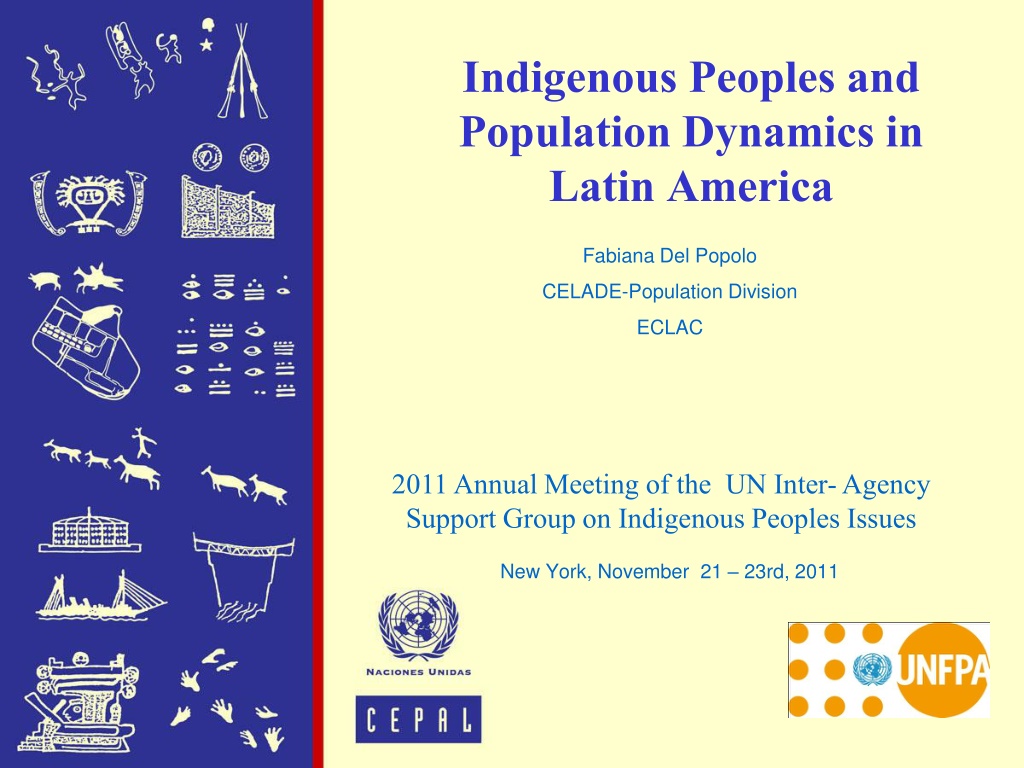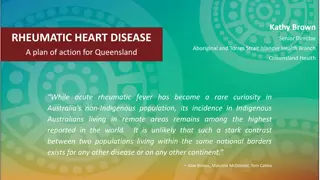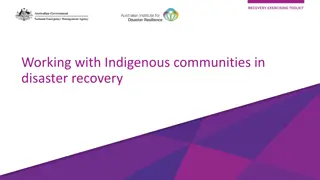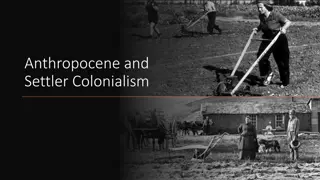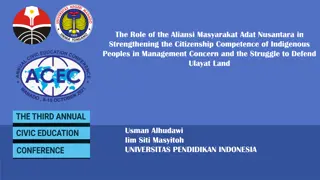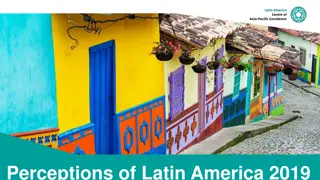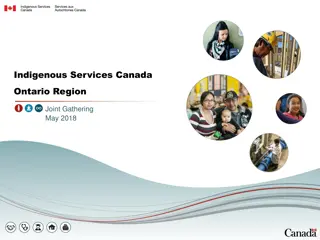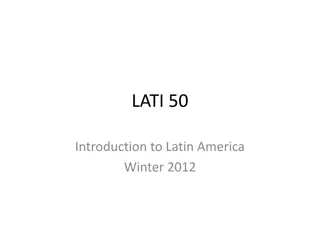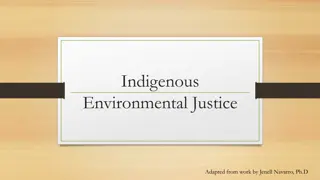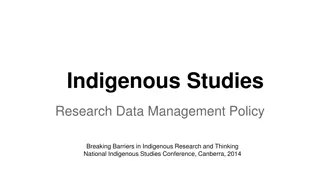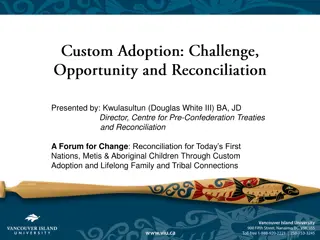Indigenous Peoples and Population Dynamics in Latin America
Latin America is a region with diverse indigenous groups, facing demands for recognition and rights. The importance of information, especially from censuses, is crucial for developing policies and programs to support indigenous peoples. Various data sources such as censuses, surveys, and registries provide insights into the demographic dynamics of indigenous populations in different countries.
Download Presentation

Please find below an Image/Link to download the presentation.
The content on the website is provided AS IS for your information and personal use only. It may not be sold, licensed, or shared on other websites without obtaining consent from the author. Download presentation by click this link. If you encounter any issues during the download, it is possible that the publisher has removed the file from their server.
E N D
Presentation Transcript
Indigenous Peoples and Population Dynamics in Latin America Fabiana Del Popolo CELADE-Population Division ECLAC 2011 Annual Meeting of the UN Inter- Agency Support Group on Indigenous Peoples Issues New York, November 21 23rd, 2011
Background Framework Latin America is a multiethnic and pluricultural region: more than 670 indigenous groups with enormous diversity Indigenous peoples constitute active political and social actors: demands for recognition Exists a minimum standard of rights (ILO Convention No. 169 y United Nations Declaration): 1. 2. 3. Right to be free from discrimination; Right to cultural integrity; Right to property, use, control and access to lands, territories and resources; Right to development and social well-being; Right to political participation, free, previous and informed consent 4. 5.
New and increasing demands for information The demand for information, a recurring theme for governments, indigenous organizations and international organizations: essential technical tool for the design, implementation and monitoring of public policy and undeniable political utility Importance of socio-demographic information, specially from census: who, how many and where are indigenous peoples constitute basic inputs for policies and programs. In particular, demographic dynamics and their inherent components fertility, mortality, and migration sustain the biological and socio-cultural reproduction of indigenous peoples
Data sources Census: among 20 countries in Latin America, 16 of them counted indigenous population) in the 2000 census decade. It will be 17 in 2010 decade. Household andDemographic and health surveys: 8-10 countries in recent surveys (sample size limitations) Education and health registries: 1 country, Brazil with systematic processing., and local experiences. In health: some advances in 5 countries (Chile, Colombia, Ecuador, Guatemala, Venezuela) peoples (or
Indigenous Peoples and censuses Decade Census 2010 (completed or planned) 2010 2010 2010 2010 2010 2011 2011 2011 2012 2012 2012 2012 2012 2015 (2013) 2015? 2017? 2017? Countries that identified indigenous peoples Argentina Brasil Ecuador M xico Panam Costa Rica Uruguay Venezuela Bolivia Chile Guatemala Honduras Paraguay Colombia Nicaragua El Salvador Per 2000 Census decade 2001 2000 2001 2000 2000 2000 --- 2001 2001 2002 2002 2001 2002 2005 2005 2007 2007
General balance 2010 census based on international and regional recommendations - Self identification criteria: review and improvement of the questions , all countries. -Other dimensions, as indigenous language, territories and ancestors, cultural perspective: improvement and new questions (Ex. Brazil, Chile, Ecuador, Mexico) -Cartography that allows the reconstruction of indigenous territories: ex. Brazil and Costa Rica. -Census process, participation, training, campaigns and institutionalization: important improvement!
Indigenous population circa 2000 Country No. % 24,0 6,3 62,2 41,0 3,4 6,8 0,4 4,6 2,2 8,6 7,0 1,1 10,1 1,7 1,7 Per M xico Bolivia Guatemala Colombia Ecuador Brasil Chile Venezuela Nicaragua Honduras Argentina Panam Paraguay Costa Rica 6.489.109 6.101.630 5.008.997 4.610.440 1.458.212 830.418 734.127 692.192 506.341 443.847 427.943 402.921 285.231 88.529 63.876 Indigenous population more than 28 millon, 2000 census decade
Indigenous population, 2010 decade: growth due to demographic components and an increase in self-identification Total Indigenous population %Indigenous population Country population Mexico 2000 2010 97.014.867 112.336.538 6.101.630 15.700.000 6,3 14,0 Growth rate (per thousand) 14,8 99,1 --- Panama 2000 2010 Growth rate (per thousand) 2.839.177 3.405.813 284.753 417.547 10,0 12,3 18,4 39,0 ---
Panama 2000 Ecuador 2001 Indigenous Indigenous 80 y m s Males 75-79 Females 70-74 65-69 60-64 55-59 50-54 45-49 40-44 Edad 35-39 30-34 25-29 20-24 15-19 10-14 5-9 0-4 0 % 10 5 5 10 Non Indigenous Non Indigenous 80 y m s 75-79 Males Females 70-74 65-69 60-64 55-59 50-54 45-49 40-44 Edad 35-39 30-34 25-29 20-24 15-19 10-14 5-9 0-4 % 10 5 0 5 10
Fertility Total fertility rate, 2000 census decade 7 6 5 4 Tasas Ind genas No ind genas 3 2 1 0 Bolivia Ecuador Panam Guatemala Chile M xico Brasil Honduras Pa ses
Percentage of youth (15-19 years old) that are mothers, rural areas, 2000 census decade
Recuperacin demogrfica y fecundidad: entre derechos individuales y colectivos Parque Ind gena do Xingu, Brazil Indigenous People Total fertility rate 2000-2007 Median Age at first child 2000-2007 Indigenous Population / year 1842 2000 1960 130-150 1967 2007 306 2007 359 Yudj 58 8,8 16,8 1 968 2000-2007 2000-2007 Ikpeng 50 6,4 15,1 Source: Pagliaro et all (2010)
Mortality Infant mortality rate (per thousand), 2000 census
Spatial distribution, internal and international migration
Population distribution according to urban-rural residence, indigenous-non indigenous urbano Rural 100 90.9 42.5 51.7 82.0 32.9 79.0 68.0 44.0 64.2 22.7 47.8 18.6 46.6 22.8 12.4 90 87.6 80 81.4 77.3 77.2 70 67.1 60 64.8 64.3 59.8 57.5 56.0 50 53.4 52.2 48.3 40 35.8 30 32.0 20 21.0 18.3 18.0 10 15.4 9.1 0 Ind genas Ind genas Ind genas Ind genas Ind genas Ind genas Ind genas Ind genas Ind genas Ind genas Paraguay 2002 Honduras 2001 Ecuador 2001 Panam 2000 Costa Rica 2000 Guatemala 2002 M xico 2000 Brasil 2000 Bolivia 2001Chile 2002
Percentage of indigenous migrants between major administrative divisions in the five years prior to the census, by age groups 14.0 12.0 10.0 8.0 6.0 4.0 2.0 0.0 5-14 a os 15-29 a os 30 y m s
Percentage of indigenous and non-indigenous international immigrant s born in bordering or other countries, by country of residence, 2000 census decade 100,0 90,0 80,0 70,0 60,0 50,0 40,0 30,0 20,0 10,0 0,0 Ind genas Ind genas Ind genas Ind genas Ind genas Ind genas Ind genas Ind genas Ind genas Ind genas No ind genas No ind genas No ind genas No ind genas No ind genas No ind genas No ind genas No ind genas No ind genas No ind genas Bolivia Brasil Chile Costa Rica Ecuador GuatemalaHonduras M xico Panam Paraguay Born in bordering countries Born in another country
Thank you www.cepal.org/celade/indigenas
